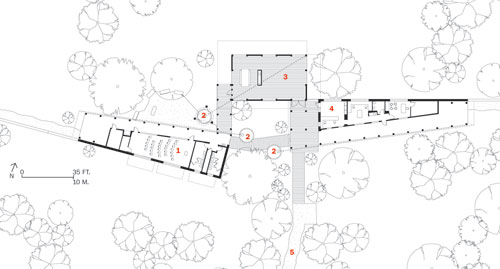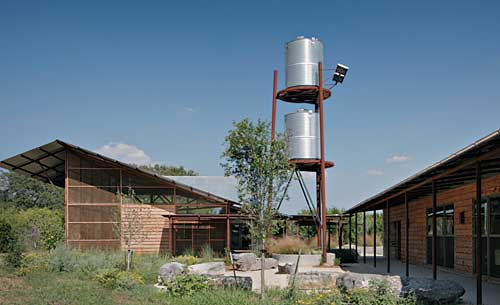Toward a Cybernetic Site
Government Canyon, gateway to an endangered aquifer
Establishing a connection to the natural environment impressed itself immediately on Lake/Flato Architects when the San Antonio−based firm undertook design on the Government Canyon Visitor Center in Helotes, Texas. The project, completed in October 2005 as a gateway to an 8,000-acre groundwater recharge conservation district, straddles the threshold of a watershed feeding the Edwards Aquifer-San Antonio's main source of water. The center's south side faces a parking lot, while the north side overlooks the periphery of the environmentally sensitive recharge zone.
Lake/Flato designed three structures-classroom, gallery, and combination administrative/gift shop buildings-all oriented around a courtyard storm-water-collection system. The sloped, corrugated-metal roofs of each building siphon rainwater into gutters and onto rain chains descending into two underground concrete cisterns (roughly 8,600 gallons each), mimicking the naturally sloped land and percolation process of the aquifer's catchment basin. A solar-powered system pumps water to a third cistern, perched atop a tower, which creates pressure for flushing toilets and what little irrigation the center's plants need. State officials rejected the use of a constructed wetland for treating sewage, arguing it could threaten public health (a common argument in many jurisdictions), so it flows into a conventional septic tank system.
|
Â
"We wanted to demarcate the edge of the recharge zone with our buildings," says Robert Harris, AIA, project architect on the Lake/Flato team. "The long wings stretching out across the landscape with dry-stacked stone walls indicate where the aquifer's preservation begins." Harris says design began with establishing the average expected annual rainfall amounts (32 inches) and then calculating how much water the roof area would collect. Once designers subtracted the amount of water needed to flush toilets, the remaining water volume determined the area of irrigated landscape the project could support. A backup valve connection to the utility water source ensures toilets will always flush. Harris notes that some rural districts view stormwater collection as robbing a watershed, but in Texas, where rapid runoff and flooding pose serious soil-erosion problems, slowing the water down helps immensely.
While visitors can't miss the stormwater-reuse system, the subtlety of the architectural moves undertaken by Lake/Flato-like the site itself-require more careful observation. For example, the architects raised the central gallery building 18 inches above grade, supporting the wood-deck floor with rusted steel pipes high enough off the ground to allow the natural flow of water underneath. A topographical survey, commissioned by the Texas Department of Parks and Wildlife, helped the architects determine how to orient the project with minimal disturbance to the watershed. "In urban watersheds, that work has been done for you, but in rural ones, you often don't discover what's happening until it's changed," Harris says. "Regional planning for watersheds is just not an institutionalized part of our development process."











